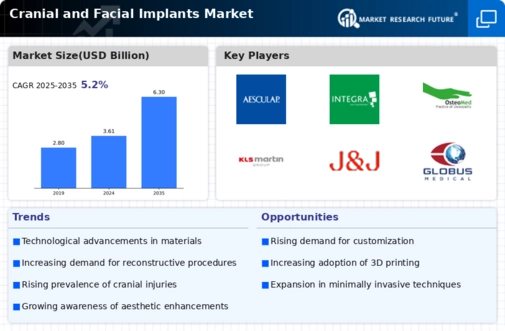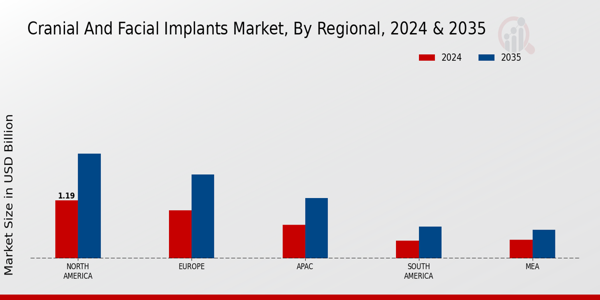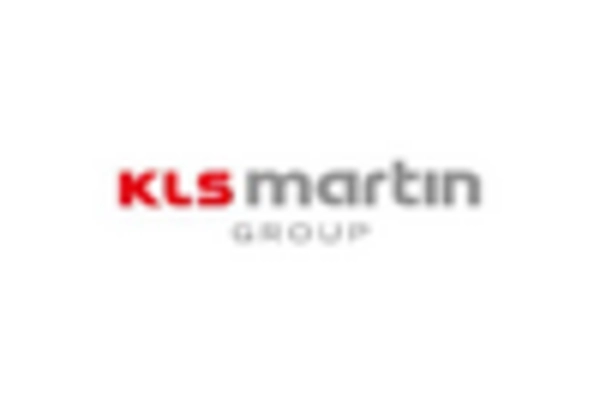Rising Geriatric Population
The rising geriatric population is a significant factor contributing to the growth of the Cranial and Facial Implants Market. As individuals age, they become more susceptible to conditions that may require cranial and facial interventions, such as osteoporosis and facial fractures. Data indicates that the population aged 65 and older is expected to double in the coming decades, leading to an increased demand for surgical solutions to address age-related deformities and injuries. This demographic shift is likely to create a robust market for cranial and facial implants, as healthcare systems adapt to the needs of an aging population. Furthermore, advancements in surgical techniques and implant materials are expected to enhance the safety and efficacy of these procedures, further driving market growth.
Expansion of Healthcare Infrastructure
The expansion of healthcare infrastructure is playing a crucial role in the development of the Cranial and Facial Implants Market. As countries invest in improving their healthcare systems, access to advanced surgical procedures is becoming more widespread. This expansion includes the establishment of specialized centers for craniofacial surgery, which are equipped with the latest technologies and skilled professionals. Market analysis suggests that regions with enhanced healthcare facilities are experiencing a surge in the number of cranial and facial surgeries performed, thereby increasing the demand for implants. Additionally, government initiatives aimed at improving healthcare access are likely to further stimulate market growth. As healthcare infrastructure continues to evolve, the Cranial and Facial Implants Market is expected to benefit from increased patient access to necessary surgical interventions.
Growing Awareness of Aesthetic Enhancements
The growing awareness of aesthetic enhancements is driving the Cranial and Facial Implants Market. As societal norms evolve, there is an increasing acceptance of cosmetic procedures aimed at improving facial appearance and correcting deformities. This trend is particularly evident among younger demographics, who are more inclined to seek surgical options for aesthetic improvements. Market data suggests that the demand for facial implants, including chin and cheek implants, has surged, with a projected growth rate of 8% annually. This rise is further fueled by the influence of social media and celebrity culture, which promote the desirability of aesthetically pleasing features. Consequently, the market is likely to expand as more individuals pursue surgical interventions to enhance their appearance, thereby driving sales of cranial and facial implants.
Technological Innovations in Implant Design
Technological innovations in implant design are significantly influencing the Cranial and Facial Implants Market. The advent of 3D printing and advanced materials has revolutionized the way cranial and facial implants are manufactured, allowing for customized solutions tailored to individual patient anatomies. This shift towards personalized implants not only improves surgical outcomes but also enhances patient satisfaction. Recent advancements indicate that the use of biocompatible materials and smart implants, which can monitor healing processes, are gaining traction. The market is expected to grow as these technologies become more accessible, with estimates suggesting a potential increase in market size by 15% over the next five years. As healthcare providers adopt these innovations, the overall efficiency and effectiveness of cranial and facial surgeries are likely to improve.
Increasing Incidence of Cranial and Facial Trauma
The rising incidence of cranial and facial trauma, attributed to factors such as road accidents, sports injuries, and violence, is a primary driver for the Cranial and Facial Implants Market. According to recent data, craniofacial injuries account for a substantial percentage of trauma cases, necessitating advanced surgical interventions. This trend is likely to propel the demand for cranial and facial implants, as healthcare providers seek effective solutions to restore functionality and aesthetics. The market is projected to witness a compound annual growth rate (CAGR) of approximately 7% over the next few years, driven by the need for innovative implant technologies that enhance patient outcomes. As the population continues to grow and urbanization increases, the prevalence of such injuries may further escalate, thereby reinforcing the market's expansion.


















Leave a Comment